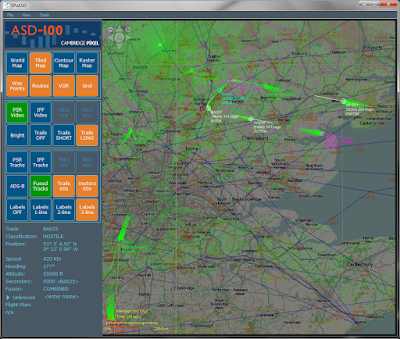Royal Thai Air Force Selects Cambridge Pixel for Air Defence Upgrade
โดยคุณ : kaypui42
ASD-100 is Cambridge Pixel's PC-based air surveillance display application for both primary and secondary radar data. It is a complete ready-to-run Windows application for display of radar and associated information, including: radar video, tracks and safety alarms. ASD-100 is designed principally for military air surveillance and ATC applications, it runs on any modern Windows (7/8/8.1) PC, accepting input data from the network in open ASTERIX formats. (all images : Cambridge Pixel)
CAMBRIDGE, United Kingdom - The Royal Thai Air Force (RTAF) has selected Cambridge Pixel (www.cambridgepixel.com), a developer of radar display and tracking subsystems, to upgrade its air defence capability at several strategic sites across the country, including air force bases and training facilities.
Engineers at the Royal Thai Air Force headquarters at Don Muang Airbase, Bangkok, Thailand, were looking for a cost-effective way to upgrade their legacy air defence processing and display hardware without replacing the existing and expensive radar sensors.
A key requirement of the upgrade was to reduce long-term maintenance costs by using commercially available (COTS) products while adding new tracking, safety and display features. These included delivering improved target tracking from both the primary and IFF (identification friend or foe) sensors, track fusion, safety alerts and then presentation of the integrated data on a large, clear PPI (plan position indicator) display on top of user-selectable maps.
The Royal Thai Air Force selected Cambridge Pixel because it was able to offer a cost-effective solution that employed the existing sensors, thereby saving considerable costs, but upgraded the processing and display to provide the enhanced capabilities needed in a modern implementation.
Commenting on the project, Group Captain Thouchpong, said: "We were very pleased with Cambridge Pixel. Their engineers understood what we needed and provided excellent support during the installation and deployment of the first two sites at Udon Thani and Nakhon Pathom. We now have an upgraded capability based on COTS products, which promises reduced long-term maintenance costs. We are looking forward to continuing the collaboration by upgrading the air defence systems at our other airbase facilities."
Cambridge Pixel has supplied RTAF with its radar processing and tracking products which interface to the existing primary and secondary (IFF) radars to provide upgraded target tracking from the primary and IFF sensors and fusion into a single track source. The display is handled by Cambridge Pixel's ASD-100 air situation display software, which provides an integrated display picture of primary and secondary video and tracks that are overlaid on maps. The software runs on standard PC hardware, thereby reducing costs of maintaining the system.
David Johnson, CEO of Cambridge Pixel, said: "This is another excellent export contract for Cambridge Pixel and it demonstrates, yet again, that the combination of our innovative software technology, radar engineering expertise and commitment to customer service is attractive to companies the world over.
"By combining our software modules for target tracking and fusion with our ASD-100 display application, we have offered a highly cost-effective upgrade to RTAF. For this project it was important that we could work with the existing radars, and our range of hardware interface cards and radar processing modules was a good match for the requirement."
Cambridge Pixel's hardware-agnostic SPx suite of software libraries and applications provide highly flexible, ready-to-run software products or 'modules-of-expertise' for radar visualisation, radar video distribution, plot extraction, target tracking and fusion.
The company's ASD-100 air situation display provides an operator with a complete and integrated picture of everything in the skies, military or commercial air traffic, whether friend or foe. This application can interface to a number of different ASTERIX data inputs including CAT-240 (radar video), CAT-48 (track reports) and CAT-4 (safety alert messages). Safety alerts such as short term conflict alerts, area proximity warnings and minimum safety altitude warnings may be sent to the ASD-100 display using Cambridge Pixel's SPx SafetyNet server application.
Cambridge Pixel's technology is used in naval, air traffic control, vessel traffic, commercial shipping, security, surveillance and airborne radar applications. Its systems have been implemented in mission critical applications with companies such as BAE Systems, Frontier Electronic Systems, Barco Defense, Blighter Surveillance Systems, DRS, Exelis, Kelvin Hughes, Lockheed Martin, Navtech Radar, Raytheon, Samsung Thales, Sofresud and Tellumat.
(Cambridge Pixel)
http://defense-studies.blogspot.com/2015/05/royal-thai-air-force-selects-cambridge.html
อืมมมม ทำให้คิดขึ้นใด้ว่า นี่เป็นศาสตร์อีกแขนงที่ไม่ค่อยใด้ยินนักวิจัย/ผลงานวิจัยในเมืองไทยพูดถึง. การพัฒนาซอฟท์แวร์เพื่อแปลงข้อมูลดิบจากเซนเซอร์ต่างๆมาเป็นกราฟฟิคเพื่อวัตถุประสงค์เกี่ยวกับ user interface/identification/ tracking/ guidance. บ้านเราใช้เครื่องมืออุตสาหกรรมที่มีองค์ประกอบลักษณะนี้มานานกว่า30ปี. (แต่ส่วนใหญ่ยังคงเป็น analog อยู่) ถ้าจะยืนด้วยลำแข้งตัวเองทางการทหาร การพัฒนาทางด้านนี้สำคัญมาก ตอนนี้ในเอเชียน่าจะเป็นเกาหลีที่เก่งสุดทางด้านนี้ รองลงมาคือญี่ปุ่ณ
ผมชอบแนวคิดเรื่อง การใช้คลื่นโทรศัพท์มือถือมาสร้างภาพแบบโซน่าร์ในเรื่อง Batman ครับ (Batman Spy System) น่าจะทำได้จริงนะครับ




อีก 2 ภาพ


โดยทางหลักการเป็นไปใด้ครับ เพราะสัญญาณโซน่าร์ และเรดาร์เป็นคลื่นแม่เหล็กไฟฟ้าเหมือนกัน ต่างกันที่ความถี่/ความยาวคลื่น ตอนนี้การสร้างภาพใต้ทะเลจากโซนาร์มีแล้วนะครับ. แต่การแปลงสัญญาณอนาลอกมาเป็นดิจิตอลเพื่อการประมาลผลต่างๆจะยากกว่ามากในกรณีของโซนาร์เพราะความถี่ที่ตำ่จะทำให้การแซมปลิ้งสัญญาณออกมาเพื่อแปลงเป็นสัญญาณดิจิตอลจะมีค่าความเพี้ยนสูง. ลิ๊งค์ข้างล่างเป็นภาพจากการสำรวจซากเรือไททานิคโดยการสร้างภาพจากsonar ครับ
http://www.dailymail.co.uk/news/article-2112456/Titanic-pictures-Extraordinary-sonar-images-map-shipwreck-ocean-floor.html
ปาด
เป็นทั้งผู้ล่า และผู้ถูกล่า


น่าสนใจนะครับ

โซนาร์ไม่ใช่คลื่นแม่เหล็กไฟฟ้านะครับ เป็นคลื่นเสียงธรรมดานี่แหละ ย่อมาจาก SOund Navigation And Range
เพียงแต่ใช้เท็คนิคเดียวกับเรดาร์ที่ใช้คลื่นแม่เหล็กไฟฟ้าในการวัดระยะ/ทิศทาง
พวกสัตว์หลายชนิดก็ใช้โซนาร์ในการนำทาง เช่นสัตว์น้ำอย่างปลาโลมาฯลฯ หรือพวกตาบอดอย่างค้างคาว ถ้าสัตว์พวกนี้ปล่อยคลื่นแม่เหล็กไฟฟ้าได้นี่คงมีงง
ที่เรือ/เรือดำน้ำใช้โซนาร์ในการตรวจจับใต้น้ำก็เพราะคลื่นเสียงเดินทางผ่านน้ำที่มีความหนาแน่นมากกว่าอากาศได้ดีกว่าคลื่นแม่เหล็กๆไฟฟ้าอย่างเรดาร์นั่นเอง
เรื่องคลื่นโทรศัพท์มือถือก็คือคลื่นแม่เหล็กไฟฟ้าเหมือนกับคลื่นวิทยุที่ใช้ในเรดาร์เพียงแต่คนละความถี่กัน คลื่นความถี่ยิ่งสูงระยะก็ยิ่งใกล้ที่กำลัง นอกจากเพิ่มกำลังส่ง
ขอบคุณท่าน toeytei ที่ปรับแก้ให้นะครับ ตามนั้นครับ โซนาร์ปล่อยออกไปเป็นคลื่นเสียง รับกลับมาก็เป็นคลื่นเสียง แล้วค่อยมาเปลี่ยนเป็นกระแสไฟฟ้าโดยรีซีฟเวอร์ ทีนี้ก็เอาสัญญาณที่แปลงใด้ไปใช้ตีความอีกที.


